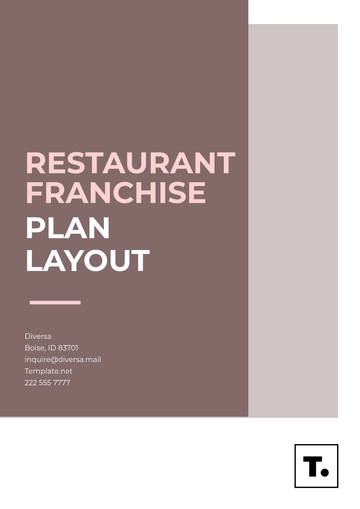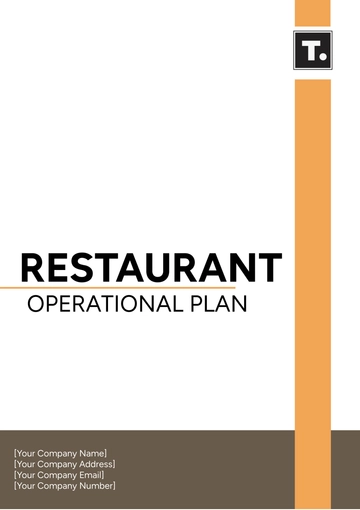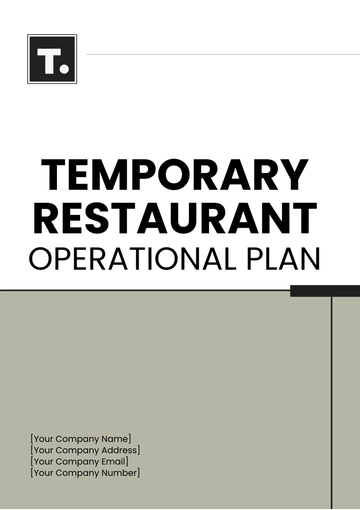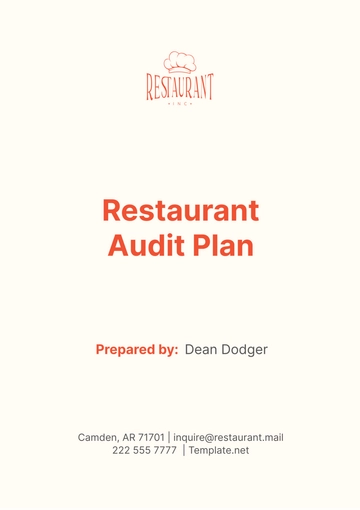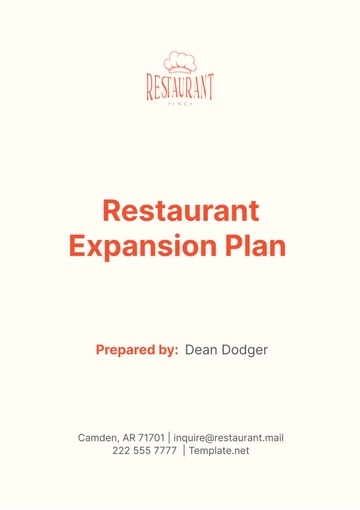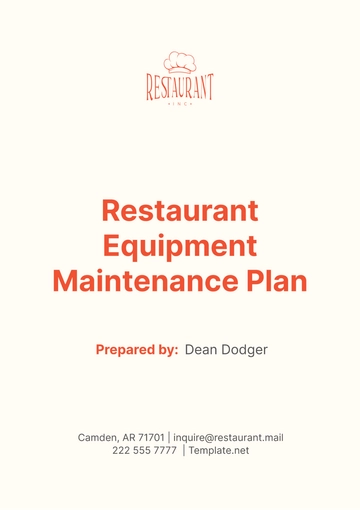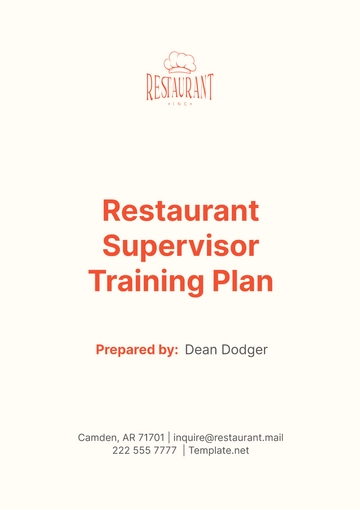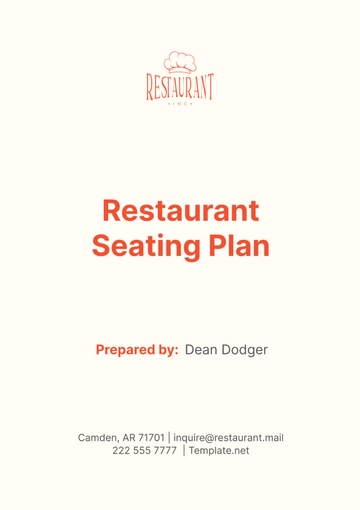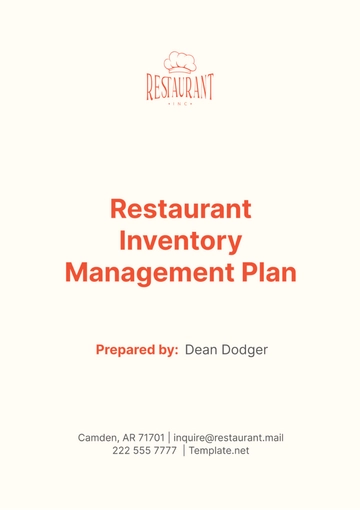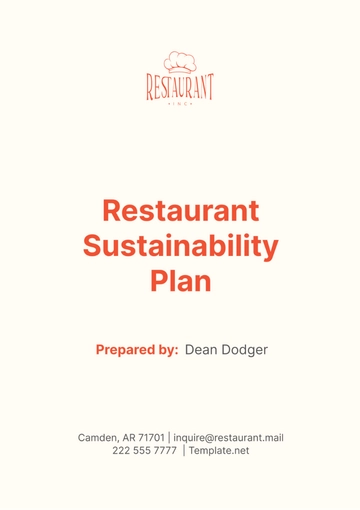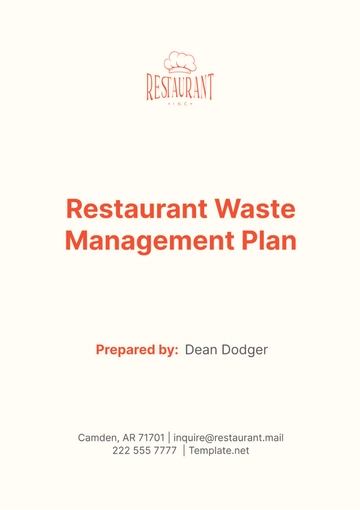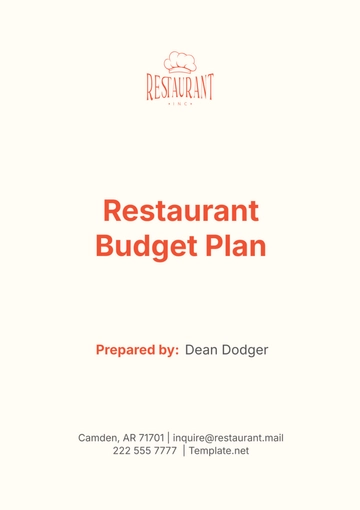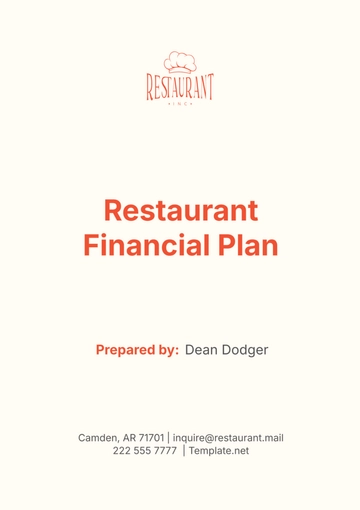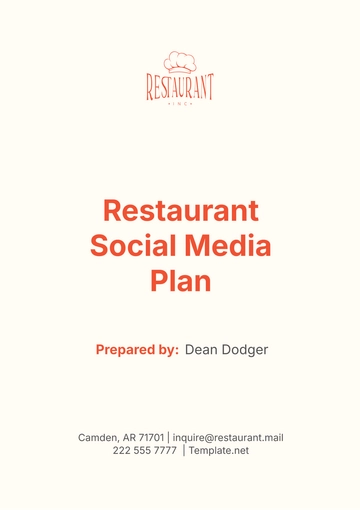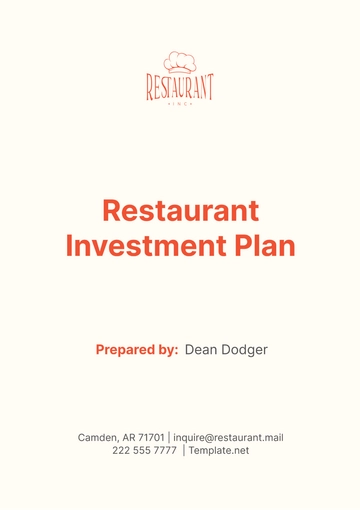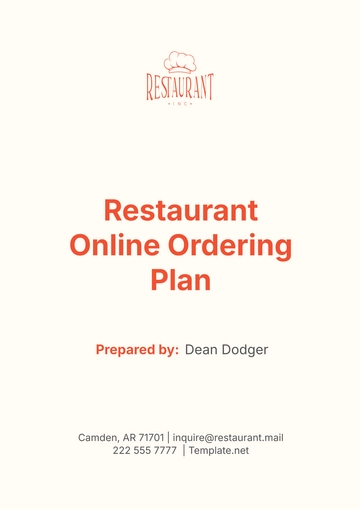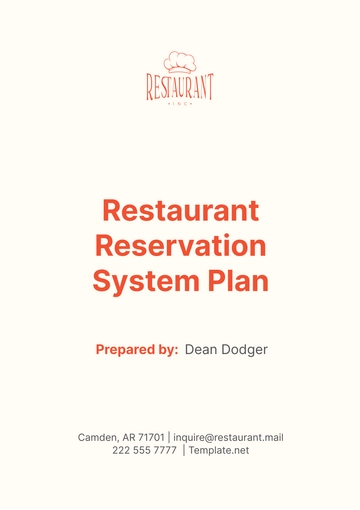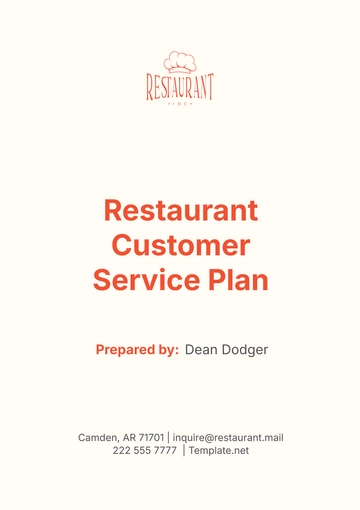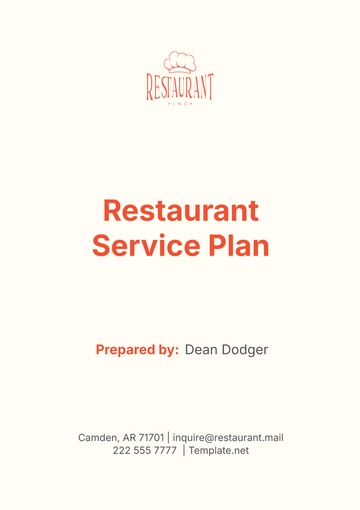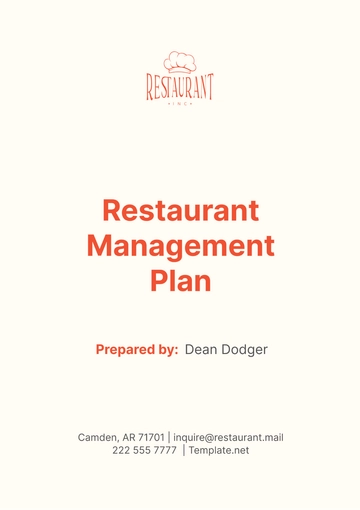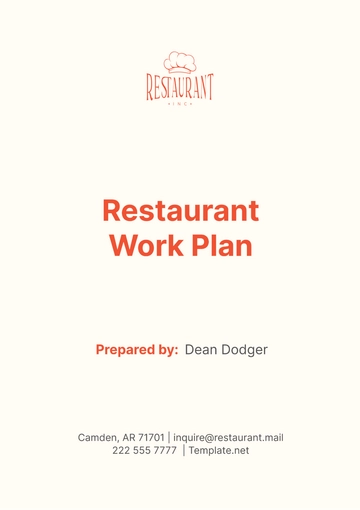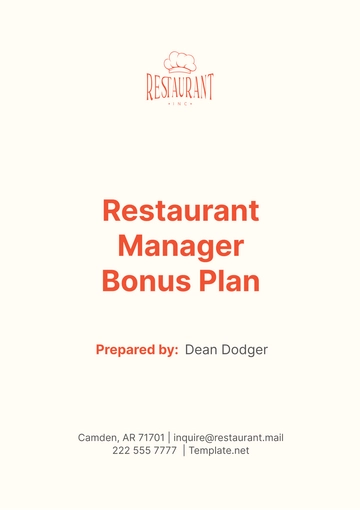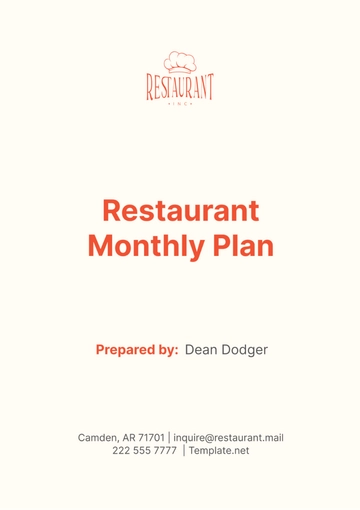Free Restaurant Service Plan
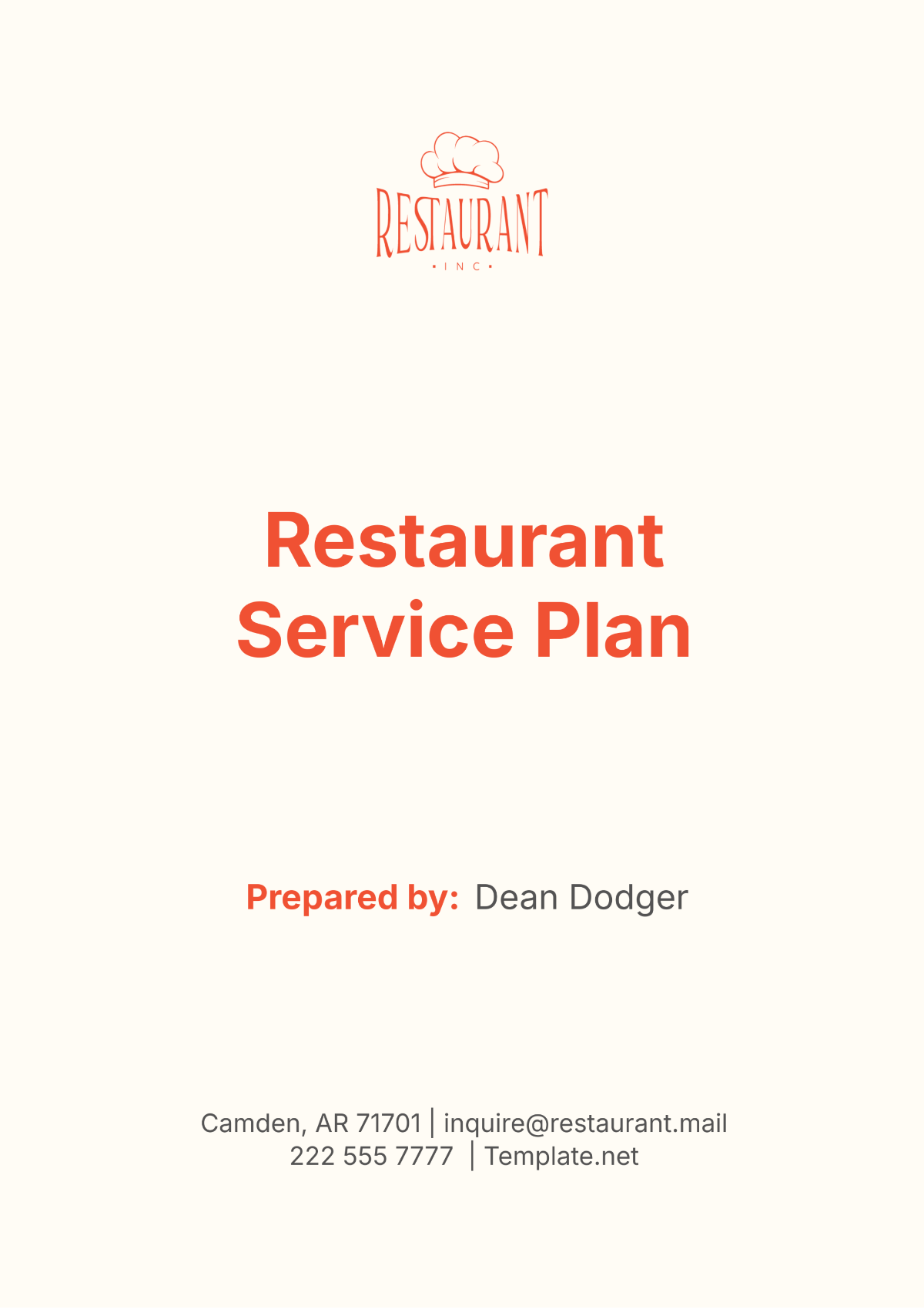
I. Objectives
The primary goal of the [Your Company Name] Restaurant Service Plan is to outline the steps necessary to provide exceptional service that aligns with our brand's unique identity and values. By enhancing the dining experience, we aim to increase customer satisfaction and loyalty, ultimately driving repeat business and positive word-of-mouth.
This plan will also focus on operational efficiency, ensuring that each team member understands their role and how it contributes to the overarching objectives of [Your Company Name]. Success metrics will be established to regularly assess and refine our service offerings.
II. Customer Service Strategy
To elevate customer service to an exceptional level, [Your Company Name] will adopt the following fundamental principles for all guest interactions, ensuring that each patron receives the highest standard of hospitality.
Immediate Acknowledgment of Guests |
Every guest will be promptly greeted upon arrival with a warm, friendly smile and a personalized greeting. Our staff will ensure that no guest waits unacknowledged, setting the tone for a welcoming and attentive dining experience. This initial interaction is crucial in making guests feel valued and appreciated from the moment they step into the restaurant. |
Continuous Engagement and Attention |
Throughout their visit, guests will receive continuous attention from our team. Waitstaff will be trained to efficiently balance attentiveness without being intrusive, ensuring that each table feels looked after. Staff will regularly check in to refill beverages, inquire if additional items are desired, and address any needs that arise, demonstrating our commitment to their comfort and satisfaction. |
Prompt Resolution of Concerns |
Should any issues arise, our team is committed to resolving them swiftly and effectively. We will empower our staff with the training and authority to handle complaints and make executive decisions on the spot. This includes offering replacements, discounts, or other compensatory measures to turn a potentially negative experience into a positive one, thereby reinforcing customer trust and loyalty. |
Personalized Service for Repeat Customers |
We will utilize a customer relationship management system to record and remember repeat customers' preferences and previous orders. This tailored approach will enable our staff to greet returning guests by name, anticipate their preferences, and make personalized recommendations based on their prior selections. This level of personalization not only enhances the dining experience but also builds a lasting relationship between our patrons and [Your Company Name]. |
Additionally, ongoing training will be provided to all staff to enhance communication skills, product knowledge, and problem-solving abilities. Regular staff meetings will be held to review customer feedback, discuss service improvements, and reinforce company culture and values.
III. Operational Efficiency
Operational efficiency at [Your Company Name] is critical for providing exceptional service and ensuring customer satisfaction. The following strategies outline our approach to streamline operations, reduce inefficiencies, and maintain the highest standards of service and cleanliness.
A. Implementation of a Digital Ordering System
To enhance the speed and accuracy of our service, [Your Company Name] will integrate a state-of-the-art digital ordering system.
1. Reduction in Wait Times and Errors
The digital system will allow customers to place orders directly from their tables using tablets or their own mobile devices, significantly reducing wait times.
Orders are transmitted instantly to the kitchen, minimizing communication errors between the waitstaff and kitchen staff.
2. Data Analytics and Management
This system will also gather data on ordering patterns, popular items, and customer preferences, allowing for better inventory management and menu adjustments.
B. High Standards of Kitchen Hygiene and Timeliness
Maintaining a clean and efficient kitchen is essential for food safety and quality.
1. Regular Cleaning Schedules
Implement strict cleaning schedules that include pre-opening, post-lunch, and closing cleanings.
Use a checklist to ensure compliance with local health regulations and standards.
2. Efficient Food Preparation
Train kitchen staff on best practices for food preparation to minimize food waste and maximize productivity.
Schedule periodic reviews and updates of kitchen workflows to improve efficiency.
C. Enhanced Communication Using Technology
Streamlining communication between front-of-house (FOH) and back-of-house (BOH) is vital for smooth operations.
1. Integrated Communication Systems
Use communication tools that integrate with the digital ordering system to keep both FOH and BOH staff informed in real-time about order changes, wait times, and customer needs.
D. Regular Equipment Maintenance
Preventing equipment failure is crucial for uninterrupted service.
1. Scheduled Maintenance
Establish a regular maintenance schedule for all kitchen equipment to ensure they are functioning efficiently and to prevent unexpected breakdowns.
Train staff to recognize signs of equipment wear and tear and report them promptly.
2. Quick Response Repairs
Maintain relationships with equipment vendors and repair services for quick response times in case of malfunctions.
IV. Marketing and Customer Engagement
To support the service objectives of [Your Company Name], marketing efforts will be strategically aligned to attract and retain customers. Initiatives include:
Targeted social media campaigns to showcase our dining experience and menu highlights.
Loyalty programs to encourage repeat visits and increase customer lifetime value.
Engaging local food bloggers and influencers to increase brand visibility and credibility.
Seasonal promotions and event nights to keep the brand experience fresh and exciting.
Customer engagement will also be enhanced by leveraging technology for feedback loops, allowing customers to easily share their dining experiences and suggestions. This immediate input will be invaluable for continuous service and menu improvement.
V. Implementation Schedule
To ensure the successful rollout of our Restaurant Service Plan, [Your Company Name] will follow a structured timeline across the calendar year. This schedule is designed to facilitate a smooth transition, allowing ample time for training, system upgrades, and the integration of new processes. By breaking down the implementation into manageable phases, we aim to optimize each component for maximum effectiveness, ensuring that both staff and customers benefit from these enhancements.
Quarter | Activities |
|---|---|
Q1 |
|
Q2 |
|
Q3 |
|
Q4 |
|
Milestones will be set for each quarter, and regular check-ins will occur to ensure that the plan is on track. Adjustments will be made based on staff feedback, customer satisfaction scores, and operational performance data.
- 100% Customizable, free editor
- Access 1 Million+ Templates, photo’s & graphics
- Download or share as a template
- Click and replace photos, graphics, text, backgrounds
- Resize, crop, AI write & more
- Access advanced editor
Craft exceptional service plans with the Restaurant Service Plan Template from Template.net. This editable and customizable document simplifies creating comprehensive service plans for your restaurant. Tailored for the food industry, it ensures seamless customization to meet your restaurant's unique service needs. Editable in our Ai Editor Tool, ensuring flexibility and ease of use.
You may also like
- Finance Plan
- Construction Plan
- Sales Plan
- Development Plan
- Career Plan
- Budget Plan
- HR Plan
- Education Plan
- Transition Plan
- Work Plan
- Training Plan
- Communication Plan
- Operation Plan
- Health And Safety Plan
- Strategy Plan
- Professional Development Plan
- Advertising Plan
- Risk Management Plan
- Restaurant Plan
- School Plan
- Nursing Home Patient Care Plan
- Nursing Care Plan
- Plan Event
- Startup Plan
- Social Media Plan
- Staffing Plan
- Annual Plan
- Content Plan
- Payment Plan
- Implementation Plan
- Hotel Plan
- Workout Plan
- Accounting Plan
- Campaign Plan
- Essay Plan
- 30 60 90 Day Plan
- Research Plan
- Recruitment Plan
- 90 Day Plan
- Quarterly Plan
- Emergency Plan
- 5 Year Plan
- Gym Plan
- Personal Plan
- IT and Software Plan
- Treatment Plan
- Real Estate Plan
- Law Firm Plan
- Healthcare Plan
- Improvement Plan
- Media Plan
- 5 Year Business Plan
- Learning Plan
- Marketing Campaign Plan
- Travel Agency Plan
- Cleaning Services Plan
- Interior Design Plan
- Performance Plan
- PR Plan
- Birth Plan
- Life Plan
- SEO Plan
- Disaster Recovery Plan
- Continuity Plan
- Launch Plan
- Legal Plan
- Behavior Plan
- Performance Improvement Plan
- Salon Plan
- Security Plan
- Security Management Plan
- Employee Development Plan
- Quality Plan
- Service Improvement Plan
- Growth Plan
- Incident Response Plan
- Basketball Plan
- Emergency Action Plan
- Product Launch Plan
- Spa Plan
- Employee Training Plan
- Data Analysis Plan
- Employee Action Plan
- Territory Plan
- Audit Plan
- Classroom Plan
- Activity Plan
- Parenting Plan
- Care Plan
- Project Execution Plan
- Exercise Plan
- Internship Plan
- Software Development Plan
- Continuous Improvement Plan
- Leave Plan
- 90 Day Sales Plan
- Advertising Agency Plan
- Employee Transition Plan
- Smart Action Plan
- Workplace Safety Plan
- Behavior Change Plan
- Contingency Plan
- Continuity of Operations Plan
- Health Plan
- Quality Control Plan
- Self Plan
- Sports Development Plan
- Change Management Plan
- Ecommerce Plan
- Personal Financial Plan
- Process Improvement Plan
- 30-60-90 Day Sales Plan
- Crisis Management Plan
- Engagement Plan
- Execution Plan
- Pandemic Plan
- Quality Assurance Plan
- Service Continuity Plan
- Agile Project Plan
- Fundraising Plan
- Job Transition Plan
- Asset Maintenance Plan
- Maintenance Plan
- Software Test Plan
- Staff Training and Development Plan
- 3 Year Plan
- Brand Activation Plan
- Release Plan
- Resource Plan
- Risk Mitigation Plan
- Teacher Plan
- 30 60 90 Day Plan for New Manager
- Food Safety Plan
- Food Truck Plan
- Hiring Plan
- Quality Management Plan
- Wellness Plan
- Behavior Intervention Plan
- Bonus Plan
- Investment Plan
- Maternity Leave Plan
- Pandemic Response Plan
- Succession Planning
- Coaching Plan
- Configuration Management Plan
- Remote Work Plan
- Self Care Plan
- Teaching Plan
- 100-Day Plan
- HACCP Plan
- Student Plan
- Sustainability Plan
- 30 60 90 Day Plan for Interview
- Access Plan
- Site Specific Safety Plan
